For organizations with established mature PAM deployments, managing the attack surface has evolved beyond simple credential vaulting and session recording. Today’s identity security professionals face increasingly complex challenges that traditional PAM solutions struggle to address effectively. This post examines the advanced technical challenges in mature PAM implementations and how a comprehensive visibility and observability framework can address these gaps.
The Visibility Crisis
Today’s enterprise environments suffer from a fundamental visibility problem that undermines even the most sophisticated PAM controls. Traditional PAM operates with an incomplete picture of the identity attack surface, creating significant blind spots that attackers exploit.
From UnitedHealthcare to Marks & Spencer, recent identity-related breaches often stem from overlooked or misconfigured identity-related issues, such as orphaned backdoor accounts or privileged accounts that slip through the cracks of even robust security controls. These incidents aren’t caused by blatant employee errors or highly skilled attackers, but by systemic issues in securing vast and complex IT environments of large organizations. It’s like setting your home alarm but forgetting to lock the front door.
This analysis reflects a broader recognition that securing the modern enterprise requires not just more tools, but a strategic overhaul of how privileged access is governed across hybrid and cloud environments. Mature PAM implementations are shifting focus to address the following foundational identity visibility challenges head-on.
Attack Path Complexity Beyond Privilege Escalation
Mature PAM implementations must take into account attack paths beyond direct privileged access. These sophisticated attack vectors typically leverage:
- Lateral Movement Across Domains: Modern privilege escalation rarely occurs within a single system. Instead, attackers traverse domain boundaries—from on-premises AD to cloud IAM to Kubernetes—following permission relationships that no single security tool monitors comprehensively.
- Missing Just-in-time Access: JIT and JEP principles cannot be implemented consistently across all data sources, making it difficult to enforce secure temporary access techniques across diverse systems and applications.
- Inheriting Permission: Discovery in a PAM system should include context of built-in and custom groups or roles that are privileged in order to fully understand the level of risk. For example, an attacker compromising a low-privilege developer account might leverage CI/CD pipeline access to inject malicious code into a deployment process that runs with elevated privileges.
Machine Identity Explosion
The explosion of non-human identities has created an administrative headache that mature PAM implementations struggle to govern:
- Service Account Proliferation: Enterprise environments now contain 80x more identities than human users, each potentially possessing elevated privileges. These service accounts often persist indefinitely without proper lifecycle management. Additionally, machine identities using oAuth tokens, encryption keys, API tokens, and certificates might not be discoverable by a traditional PAM solution.
- Ephemeral Identity Management Gaps: Containerized and serverless environments generate thousands of short-lived identities with just-in-time privileges. Traditional PAM solutions were not designed to keep pace with this velocity, creating a governance vacuum.
- Credential Distribution Complexity: Machine identity credentials disperse across infrastructure-as-code repositories, CI/CD pipelines, secrets management systems, and runtime environments—each representing a potential compromise vector outside traditional PAM governance.
Multi-Cloud, On-premises, and Hybrid Identity Management
As enterprises adopt hybrid and multi-cloud architectures, maintaining consistent privileged access controls becomes exponentially more complex:
- Non-Standardized Privilege Models: Each cloud provider implements fundamentally different authorization models, making standardized privilege assessment nearly impossible. Organizations need to have a comprehensive view of access rights across all systems and the context behind every entitlement by understanding built-in privileged groups and roles to ensure privileged access levels are applied correctly across disparate apps.
- Controls Fragmentation: PAM policies that are applicable only to modern cloud apps may necessitate a secondary PAM control. Each cloud provider implements privileged access differently—with unique concepts like AWS IAM roles, Azure managed identities, and GCP service accounts—making it difficult for a single PAM solution to natively handle all privileged credential types across environments.
Ephemeral Resource Security
Cloud-native architectures fundamentally change the privileged access landscape through their emphasis on ephemeral resources:
- Infrastructure Lifecycle Mismatch: When compute resources have lifespans measured in minutes or seconds, traditional PAM authorization may be ignored and usually require an additional module or even another dedicated solution to support more dynamic devops requirements.
- Secret Injection Security Gaps: Securely injecting credentials into ephemeral resources requires deep integration with orchestration platforms that traditional PAM solutions lack.
- Dynamic Configuration Risk: Infrastructure-as-code and configuration-as-code introduce new privileged access paths, where configuration changes themselves can represent new privilege escalation opportunities.
PAM’s Visibility & Observability Framework
Addressing these intricate challenges demands total visibility, ongoing observability, and solid PAM processes. A cohesive visibility and observability framework delivers this by seamlessly integrating continuous identity discovery, enriched and consistent identity data, monitoring for anomalous privileged activity, and effective remediation.
How Hydden Unlocks Your PAM Solution’s Potential
For organizations maturing PAM beyond credential vaulting, Hydden provides the visibility foundation and intelligence layer necessary to address the most difficult PAM challenges. PAM teams can close critical gaps in their identity security posture and demonstrate measurable risk reduction to their CISOs in the challenges we’ve previously discussed in this blog:
Comprehensive Attack Path Visibility
Hydden provides monitoring and alerting of complex attack paths through:
- Relationship Identity Mapping: Continuous discovery of all identity relationships across domains, enabling visualization of multi-hop attack paths
- Cross-Domain Permission Analysis: Normalization of privileges across systems to proactively reveal privilege escalation paths
- Understand Risks: Identification of accounts that are NOT utilizing credential rotation, time-bound access, and other indicators of risk
Machine Identity Management
Hydden addresses machine identity challenges through:
- Rapid Total Discovery: Continuous identification of all machine identities across environments, including ephemeral service accounts, API keys, and certificates
- Privilege Assessment: Comprehensive evaluation of permissions for non-human identities across disparate systems
- Lifecycle Monitoring: Detecting orphaned, dormant, or breached machine identities that create persistent privilege escalation paths
Multi-Cloud Consistency
Hydden enables consistent privileged access governance across hybrid environments:
- Unified Visibility Layer: Single-pane-of-glass visibility with enriched identity data across on-premises, cloud, and SaaS systems that can be utilized by your PAM solution
- Normalized Permission Model: Standardized view of privileges across different platforms, enabling consistent risk assessment
- Non-Cloud Specific Risk Detection: Platform-specific detection of privilege escalation risks unique to each on-premises, hybrid, or cloud provider
Ephemeral Resource Management
Hydden adapts to the velocity of modern infrastructure:
- Real-Time Event-Based Discovery: Continuous identification of new privileged entities as they are created, regardless of lifespan
- Dynamic Risk Assessment: Continuous evaluation of privilege risk posture as infrastructure evolves
If you’re still reading, you definitely need to get a demo and start your trial: https://hydden.com/book-demo/





